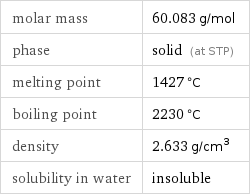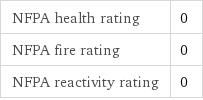Input interpretation

quartz
Chemical names and formulas

formula | SiO_2 Hill formula | O_2Si name | quartz IUPAC name | dioxosilane alternate names | crystalline silica | crystalline silicon dioxide | dioxosilane | sand | silicon(IV) oxide mass fractions | O (oxygen) 53.3% | Si (silicon) 46.7%
Lewis structure

Draw the Lewis structure of quartz. Start by drawing the overall structure of the molecule, ignoring potential double and triple bonds: Count the total valence electrons of the oxygen (n_O, val = 6) and silicon (n_Si, val = 4) atoms: 2 n_O, val + n_Si, val = 16 Calculate the number of electrons needed to completely fill the valence shells for oxygen (n_O, full = 8) and silicon (n_Si, full = 8): 2 n_O, full + n_Si, full = 24 Subtracting these two numbers shows that 24 - 16 = 8 bonding electrons are needed. Each bond has two electrons, so in addition to the 2 bonds already present in the diagram add 2 bonds. To minimize formal charge oxygen wants 2 bonds and silicon wants 4 bonds. Identify the atoms that want additional bonds and the number of electrons remaining on each atom: Fill in the 2 bonds by pairing electrons between adjacent highlighted atoms: Answer: | |
Basic properties

molar mass | 60.083 g/mol phase | solid (at STP) melting point | 1427 °C boiling point | 2230 °C density | 2.633 g/cm^3 solubility in water | insoluble
Units

Solid properties (at STP)

density | 2.633 g/cm^3 vapor pressure | 10 mmHg (at 1732 °C)
Units

Thermodynamic properties

molar heat of fusion | 8.5 kJ/mol specific heat of fusion | 0.1415 kJ/g (at STP)
Chemical identifiers
![CAS number | 14808-60-7 PubChem CID number | 24261 SMILES identifier | O=[Si]=O EU number | 238-878-4 Gmelin number | 13882 RTECS number | VV7330000](../image_source/9bc832d8fd3274e0b0bb5ebe9fcac2a3.png)
CAS number | 14808-60-7 PubChem CID number | 24261 SMILES identifier | O=[Si]=O EU number | 238-878-4 Gmelin number | 13882 RTECS number | VV7330000
NFPA label

NFPA label

NFPA health rating | 0 NFPA fire rating | 0 NFPA reactivity rating | 0
Toxicity properties

RTECS classes | tumorigen | mutagen | human data